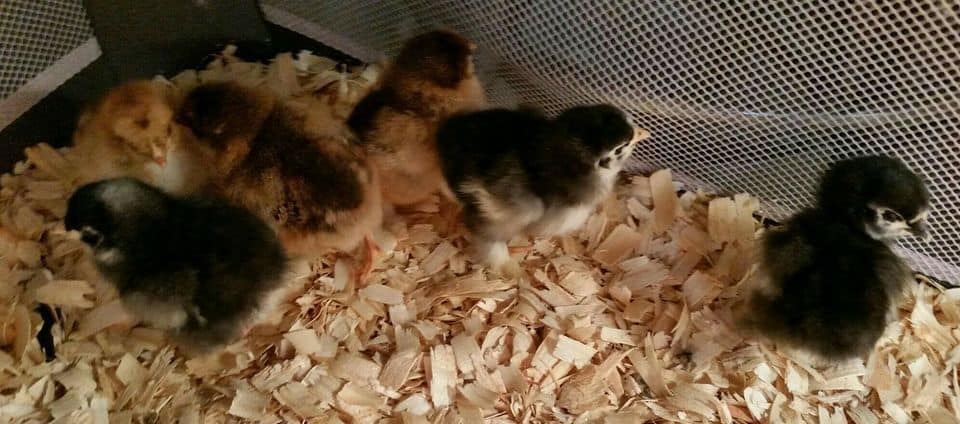
I recently raised my fourth flock of baby chickens without a hen at home and wanted to share some tips and tricks I learned along the way.
If you are thinking about raising baby chicks or just want to know how to take care of baby chicks once you bring them home this article is for you.
Why Hand-Raise Chickens?
Hand-raised chickens will generally be of a “sweeter” disposition, meaning they will see you as their mother and will be friendlier with people, this ideal for pet chickens and any chicken that will be around children, like backyard or urban chickens.
7 Steps To Raise Baby Chicks Without Hen
1. Have A Brooding Box
If raising a small number of chicks this brooding box can be anything that has sides about 18 inches high. You want to make sure that it won’t melt or catch fire under a heat lamp. We used an aquarium and made a cover using chicken fencing.
Baby chickens need about 6 square inches of space for the first two weeks, after which it should be 1 square foot of space per chicken. During this time the chicks will be chirping a lot.
We moved our chickens to a toddler playpen once they got bigger.
2. Keep The Baby Chickens Warm
Baby chickens need to be kept warm until they are fully feathered and can keep themselves warm. This usually takes between 4-6 weeks. Until then if you are raising them by hand they need to be under a heat lamp, preferably with a red light bulb.
Other heat sources like heat plates or infrared lamps are also good supplemental heat options. If your babies were shipped they most likely came with a thermometer, otherwise, you should purchase one.
For the first two weeks of life, the baby chicks brooder temperature should be between 95-100 degrees Fahrenheit at the bottom where the chicks are. After that, the temp should be lowered by five degrees per week until fully feathered.
You can lower the temp by adjusting the height of your heat lamp, move it closer to increase the temp or further to reduce the temp.
If your chicks are huddled together then they need the lamp lowered.
If you see them panting or far apart raise the lamp to lower the temp.
3. Have the Proper Bedding
While chicks are little you want to make sure that you have proper and sufficient bedding for their legs to develop properly.
Fold two or more pieces of newspaper or paper towels to fit the bottom of your container then cover that with 2-3 inches of bedding. The bedding can be wood shavings, corn cobs, oat hulls, or chopped straw.
The bedding keeps the floor from getting too slippery for the chicks, and having the newspaper on the bottom means you can easily clean the brooder by rolling up the newspaper, bedding, and all.
I then add the newspaper and bedding to my compost pile.
4. Keep Food and Water Clean
Baby chickens need to be fed chick starter feed in the first 20 weeks of life. Starter feed has a higher protein ratio of about 20% protein, after the first few months then you can switch the feed to layer feed if raising hens for eggs.
Place the food into a chicken feeder and place it on the bottom of the box.
Freshwater should also be in a chick water fount, if you place water in a bowl or saucer the chickens are likely to knock it over, wet bedding breeds many issues for little chicks.
I add a splash of apple cider vinegar to the water to help with the pasty butt.
Keep the water temp warm for the first few days, around 98 degrees, to keep the babies warm.
Coldwater will drop their temperature and cause them to go into shock. Check the water a few times per day as the chicks kick the dirty bedding into the water dispenser.
When your baby chicks reach 8 weeks of age or earlier you will need to give them chick grit. If you are letting them outside during the day you should start giving them grit immediately.
The grit will accumulate in their gizzard. This will allow them to grind up food particles for digestion.
5. Keep Bottoms Clean (Prevent Pasty Butt)
Pasty Butt, or bottom pasting when raising chicks is very common. This is when the soft droppings remain on the rear end of the chicken, dry up and then clog the anal vent shut. When left untreated, a pasty butt will kill your baby chick.
The good news is that it is easy to take care of.
I wet a paper towel and hold it to the clicks rear end until the paste softens then I remove the paste and a few feathers around the vent to keep the area clean.
Add two tablespoons of apple cider vinegar to one quart of water to help cut down on pasty butt.
Avoid stressing your birds and try to get them drinking water as soon as you get them home.
6. Slowly Introduce Them to the Outdoors
Once your chickens have feathers, you can start to bring them outside on warm and sunny days. Use a pen to keep them safe and contained. Keep a close eye on your birds while they are outside.
Providing them with a dust bath while outside encourages them to start cleaning themselves early.
7. Stay Safe and Wash Your Hands
As always when handling chickens, avoid cross-contamination by washing your hands after touching chickens or handling any of the feeders.
When coming in from outside, leave your shoes in a safe area, preferably outside so you aren’t tracking disease into your house.
I see many pictures of people allowing their chickens to roam freely inside, please remember that chickens poop as they walk, then they step in that poop and track it all over your house.
While it may be cute, it’s also spreading illnesses.
Adult supervision of children while handling chicks is important, as they have a tendency to touch their mouths and faces, prevention of salmonella is much better than treating it.
Once your chickens are about 6 weeks of age and your outdoor temperatures are above 65 degrees, then they can be transferred to the main coop.
I have bantams currently so I waited until 8-10 weeks so that they could get bigger before transferring them to the outdoor coop.
How long do baby chicks need a heat lamp?
You need to keep baby chicks under a heat lamp for the first 4-6 weeks of their life.
The ideal temperature for chicks at seven days old or younger is 95 degrees Fahrenheit. At week two the temperature should between 90-95 degrees Fahrenheit, at week three is 85 degrees Fahrenheit.
Basically each week the required temperature declines by 5 degrees until the chicks are ready to live outdoors in their coop.
Can You Raise Baby Chicks Without a Heat Lamp?
Baby chicks need constant heat at 90-95 degrees Fahrenheit when they are first hatched. Using a heat lamp is the easiest and best way to mimic nature.
If for some reason you do not have electricity you would need to build a well-insulated nest that could be put next to some type of heat source to maintain the required temperature.
Can I leave a Heat Lamp On All Night?
Yes you can leave the heat lamp on all night when raising baby chicks. The temperature needs to remain even throughout the night so the chicks don’t get cold.
How to Tell If Baby Chicks Are Too Hot
If the baby chicks are too hot you may notice them spread all around the heat lamp trying to avoid being directly under it. If you notice the baby chicks panting that also means its too hot in your brooder.
Raise your heat lamp another few inches and this should fix the issue.
How Long Can Baby Chicks Survive in the mail?
Baby chicks have been sent through the mail since 1918. This is when the post office first started allowing the process. Baby chicks can survive for 72 hours before needing food or water thanks to ingesting the egg yolk nutrients right before they hatch.
Conclusion
Raising baby chicks is a very rewarding experience. I know my young daughter loved it when we first got baby chickens. She enjoyed holding them and taking care of them each day.
Looking for baby chicks? Check out this article for where to buy baby chicks at hatcheries with a small minimum order size if you’re looking for less than 15 chicks.

